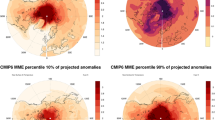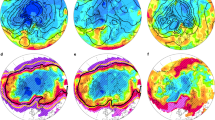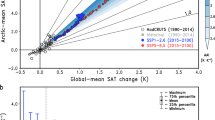Abstract
Climate change is amplified in the Arctic region. Arctic amplification has been found in past warm1 and glacial2 periods, as well as in historical observations3,4 and climate model experiments5,6. Feedback effects associated with temperature, water vapour and clouds have been suggested to contribute to amplified warming in the Arctic, but the surface albedo feedback—the increase in surface absorption of solar radiation when snow and ice retreat—is often cited as the main contributor7,8,9,10. However, Arctic amplification is also found in models without changes in snow and ice cover11,12. Here we analyse climate model simulations from the Coupled Model Intercomparison Project Phase 5 archive to quantify the contributions of the various feedbacks. We find that in the simulations, the largest contribution to Arctic amplification comes from a temperature feedbacks: as the surface warms, more energy is radiated back to space in low latitudes, compared with the Arctic. This effect can be attributed to both the different vertical structure of the warming in high and low latitudes, and a smaller increase in emitted blackbody radiation per unit warming at colder temperatures. We find that the surface albedo feedback is the second main contributor to Arctic amplification and that other contributions are substantially smaller or even opposeArctic amplification.
This is a preview of subscription content, access via your institution
Access options
Subscribe to this journal
Receive 12 print issues and online access
$259.00 per year
only $21.58 per issue
Buy this article
- Purchase on Springer Link
- Instant access to full article PDF
Prices may be subject to local taxes which are calculated during checkout



Similar content being viewed by others
References
Barron, E. J. A warm, equable cretaceous: The nature of the problem. Earth-Sci. Rev. 19, 305–338 (1983).
Dahl-Jensen, D. et al. Past temperatures directly from the greenland ice sheet. Science 282, 268–271 (1998).
Chapman, W. L. & Walsh, J. E. Recent variations of sea ice and air temperature in high latitudes. Bull. Am. Meteorol. Soc. 74, 33–47 (1993).
Bekryaev, R. V., Polyakov, I. V. & Alexeev, V. A. Role of polar amplification in long-term surface air temperature variations and modern arctic warming. J. Clim. 23, 3888–3906 (2010).
Manabe, S. & Wetherald, R. The effects of doubling the CO2 concentration on the climate of a general circulation model. J. Atmos. Sci. 32, 3–15 (1975).
Holland, M. & Bitz, C. Polar amplification of climate change in coupled models. Clim. Dynam. 21, 221–232 (2003).
Serreze, M. C. & Francis, J. A. The arctic amplification debate. Climatic Change 76, 241–264 (2006).
Screen, J. A. & Simmonds, I. The central role of diminishing sea ice in recent arctic temperature amplification. Nature 464, 1334–1337 (2010).
Crook, J. A., Forster, P. M. & Stuber, N. Spatial patterns of modeled climate feedback and contributions to temperature response and polar amplification. J. Clim. 24, 3575–3592 (2011).
Taylor, P. C. et al. A decomposition of feedback contributions to polar warming amplification. J. Clim. 26, 7023–7043 (2013).
Hall, A. The role of surface albedo feedback in climate. J. Clim. 17, 1550–1568 (2004).
Graversen, R. G. & Wang, M. Polar amplification in a coupled climate model with locked albedo. Clim. Dynam. 33, 629–643 (2009).
Arrhenius, S. On the influence of carbonic acid in the air upon the temperature of the ground. London, Edinburgh, Dublin Phil. Mag. J. Sci. 41, 237–276 (1896).
IPCC. Climate Change 2007: The Physical Science Basis (Cambridge Univ. Press, 2007)
Winton, M. Amplified Arctic climate change: What does surface albedo feedback have to do with it?. Geophys. Res. Lett. 33, L03701 (2006).
Vavrus, S. The impact of cloud feedbacks on Arctic climate under greenhouse forcing. J. Clim. 17, 603–615 (2004).
Bintanja, R., van der Linden, E. & Hazeleger, W. Boundary layer stability and Arctic climate change: A feedback study using EC-Earth. Clim. Dynam. 39, 2659–2673 (2012).
Manabe, S. & Wetherald, R. T. On the distribution of climate change resulting from an increase in CO2 content of the atmosphere. J. Atmos. Sci. 37, 99–118 (1980).
Khodri, M. et al. Simulating the amplification of orbital forcing by ocean feedbacks in the last glaciation. Nature 410, 570–574 (2001).
Spielhagen, R. F. et al. Enhanced modern heat transfer to the arctic by warm atlantic water. Science 331, 450–453 (2011).
Planck, M. Ueber das gesetz der energieverteilung im normalspectrum. Ann. Phys. 309, 553–563 (1901).
Soden, B. et al. Quantifying climate feedbacks using radiative kernels. J. Clim. 21, 3504–3520 (2008).
Zhang, M., Hack, J., Kiehl, J. & Cess, R. Diagnostic study of climate feedback processes in atmospheric general circulation models. J. Geophys. Res. 99, 5525–5537 (1994).
Hansen, J., Sato, M. & Ruedy, R. Radiative forcing and climate response. J. Geophys. Res.: Atm. 102, 6831–6864 (1997).
Held, I. & Shell, K. Using relative humidity as a state variable in climate feedback analysis. J. Clim. 25, 2578–2582 (2012).
Bintanja, R. & van der Linden, E. The changing seasonal climate in the arctic. Sci. Rep. 3, 1556 (2013).
Serreze, M., Schnell, R. & Kahl, J. Low-level temperature inversions of the Eurasian Arctic and comparisons with Soviet drifting station data. J. Clim. 5, 615–629 (1992).
Hwang, Y-T., Frierson, D. M. & Kay, J. E. Coupling between arctic feedbacks and changes in poleward energy transport. Geophys. Res. Lett. 38, L17704 (2011).
Held, I. M. & Soden, B. J. Robust responses of the hydrological cycle to global warming. J. Clim. 19, 5686–5699 (2006).
Block, K. & Mauritsen, T. Forcing and Feedback in the MPI-ESM-LR coupled model under abruptly quadrupled CO2 . J. Adv. Model. Earth Syst. 5, 1–16 (2013).
Acknowledgements
We gratefully acknowledge K. Block for providing the radiative kernels used here and helping with their application, B. Stevens for discussions of the research and L. Tomassini for comments and feedback on the present manuscript.
Author information
Authors and Affiliations
Contributions
T.M. developed the ideas that led to this paper. F.P. developed the inverted kernel method, analysed the model data and wrote the main paper with comments and input from T.M.
Corresponding author
Ethics declarations
Competing interests
The authors declare no competing financial interests.
Rights and permissions
About this article
Cite this article
Pithan, F., Mauritsen, T. Arctic amplification dominated by temperature feedbacks in contemporary climate models. Nature Geosci 7, 181–184 (2014). https://doi.org/10.1038/ngeo2071
Received:
Accepted:
Published:
Issue Date:
DOI: https://doi.org/10.1038/ngeo2071
This article is cited by
-
Linking drought indices to atmospheric circulation in Svalbard, in the Atlantic sector of the High Arctic
Scientific Reports (2024)
-
Satellite-observed strong subtropical ocean warming as an early signature of global warming
Communications Earth & Environment (2023)
-
Seasonally distinct contributions of greenhouse gases and anthropogenic aerosols to historical changes in Arctic moisture budget
npj Climate and Atmospheric Science (2023)
-
Database of daily Lagrangian Arctic sea ice parcel drift tracks with coincident ice and atmospheric conditions
Scientific Data (2023)
-
Robust and perfectible constraints on human-induced Arctic amplification
Communications Earth & Environment (2023)



